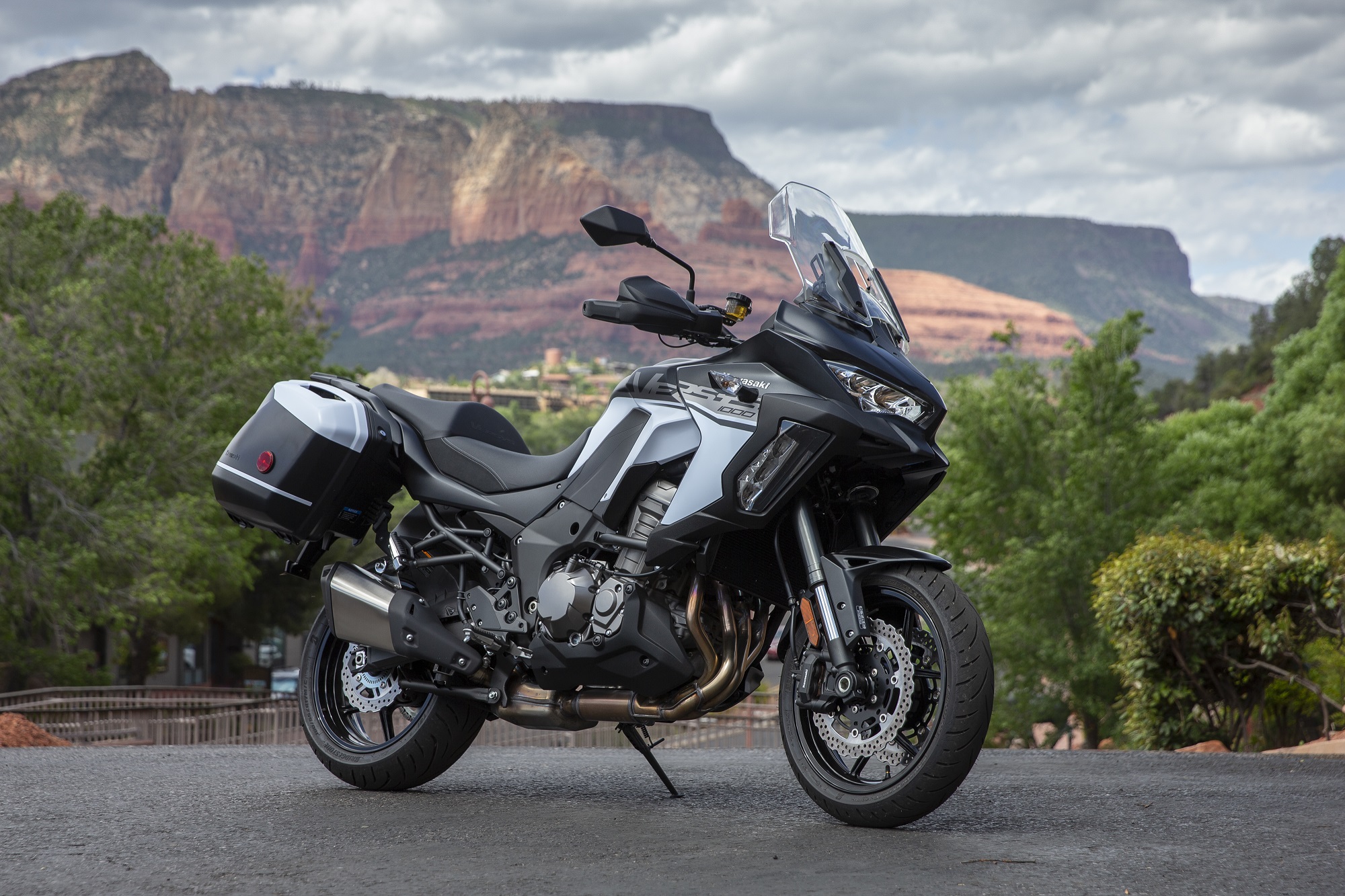
The 2019 Kawasaki Versys 1000 SE LT+. Photo by Kevin Wing.
When I reviewed the Kawasaki Versys 1000 LT three and a half years ago, it was a well equipped, competent, sport-touring motorcycle at a relatively bargain price of $12,799. For 2019, Kawasaki has positioned the Versys in a different niche of the sport-touring market by adding an array of technology and features, many of them straight off the upscale, supercharged H2 SX SE, and the price has risen accordingly to $17,999.
Now, instead of being a comfier competitor to something like Yamaha’s Tracer GT, the biggest entry in the Versys lineup is matching features with pricey Europeans like the BMW S 1000 XR, the Ducati Multistrada 1260 S and the KTM 1290 Superduke GT. All those European bikes are more powerful, but they’re also all still more expensive.
Kawasaki felt it only made sense to apply its best electronic rider aids to the bike and the additions are numerous and significant: an inertial measurement unit allows for lean-angle-sensitive anti-lock braking and traction control; electronic suspension adjustment reacts to changes in the road in a millisecond and adjusts damping on the fly; there’s cruise control, the LED cornering lights from the H2 and a TFT dash for displaying all that’s going on. Plus, if you download Kawasaki’s Rideology app, you can adjust the suspension from your smartphone or record information from your rides — not just your route, but also the lean angle, braking force, speed and other data from along the way.
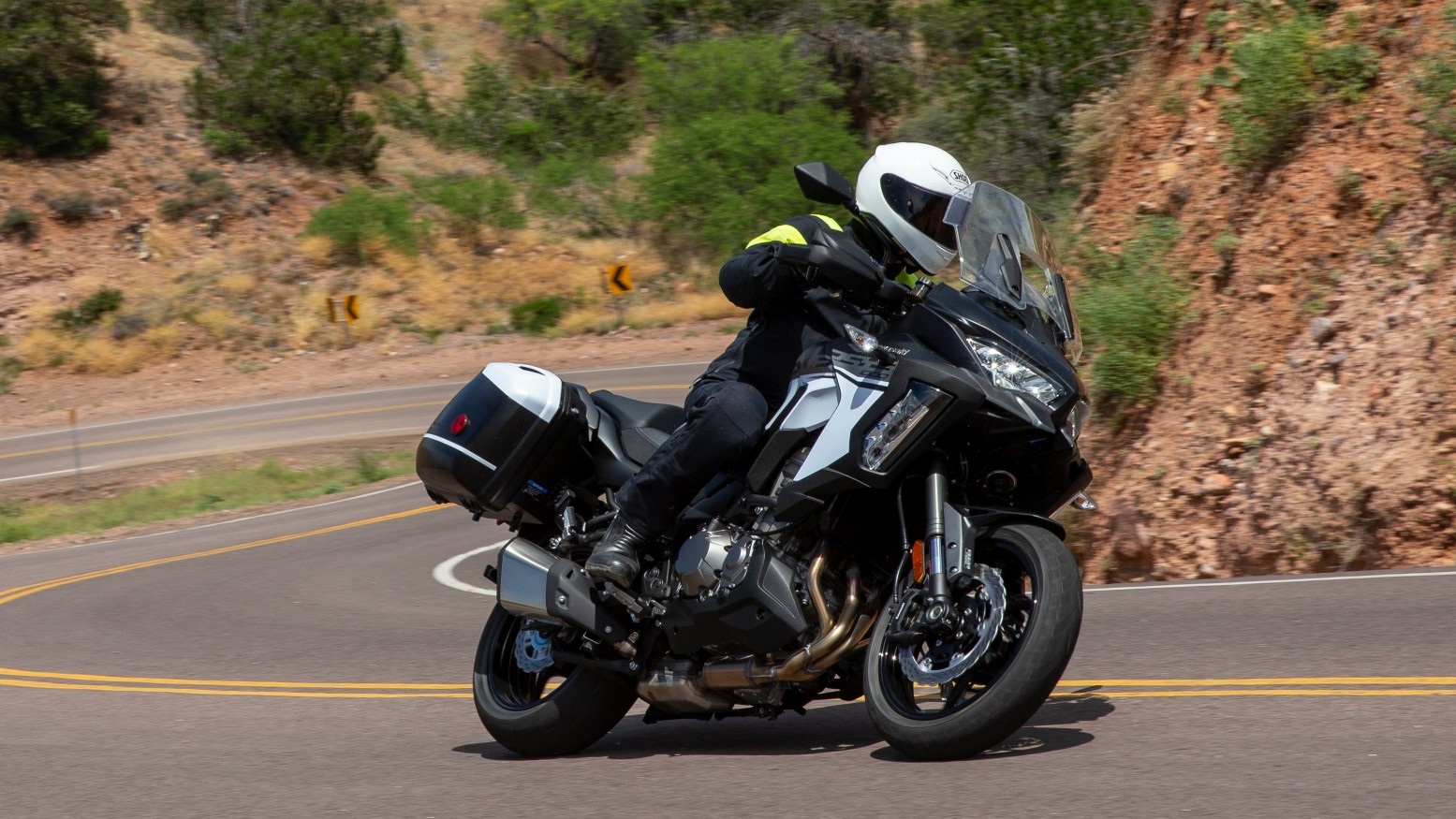
Riding the Kawasaki Versys 1000 SE LT+ in Arizona. Photo by Kevin Wing.
To see how it all worked, I went to Kawasaki’s press intro in Arizona, where we had two days of riding from Scottsdale to Flagstaff, with stops in Prescott and Sedona. In other words, all kinds of riding from freeways to curvy backroads and through some dramatic scenery. Better yet, Kawasaki let me keep the bike and ride it back east. Eventually, I’ll take it to RevZilla headquarters in Philadelphia where the rest of the Common Tread team will try it, as well, but for now I’m piling on big miles (4,211 and counting, as of this writing) to see how it works.
While the suspension and electronics are the big changes, the engine is still the heart of any motorcycle. So let’s start with what’s mostly unchanged.
The 1,043 cc four-cylinder heart of the Versys 1000 SE LT+
Minor changes were made to the engine, such as electronic throttle valves, different fuel mapping and revised injectors, but this is mostly the same engine that was in the previous Versys or even the Ninja 1000 I also rode back then. That’s not a bad thing.
For a sport-touring motorcycle, I like smooth, drama-free power. A rorty engine with some vibes and “character” may be fun for a 50-mile weekend ride, but when you’re doing 2,000 miles in three days, as I did on my ride home from Arizona, that kind of character gets old. And tiring.
The engine in the Versys just pulls from low rpm up to its 10,000 rpm redline with no noticeable peaks or valleys in the torque curve. Kawasaki says torque tops out at 75.2 foot-pounds at 7,500 rpm (same as the previous model), and it does feel strong at that spot on the analog tachometer, but no matter how fast you’re spinning the engine, a twist of the throttle produces a surge of forward motion. The best way I can describe it that the Versys 1000 is a fast motorcycle that doesn’t feel fast. There’s no hit of power at the bottom, like some grunty V-twins, or at the top, like a liter-class sport bike. It just presses you forward.
Best of all, fueling is nearly perfect. If I try, I can find a tiny bit of lurchiness at the transition from fully closed throttle to slightly open, but it’s better than the vast majority of engines in these days of strict emissions laws.
Three preset rider modes are labeled Sport, Road and Rain. Sport and Road provide full power and varying levels of intervention by the traction control and ABS, while Rain provides 75 percent power and more traction control and ABS intervention. The modes also adjust the suspension settings, which I’ll get into later. There’s a fourth mode, Rider, that you can customize to your preferences. It should be noted that unlike most bikes with similar electronic aids, the throttle response does not change with the mode. On many bikes today, using the “Sport” or similar rider mode makes the throttle so twitchy it’s unpleasant to ride. That’s not the case with the Versys.
When I first rode the bike at the press intro, I felt some buzziness that came on at 6,000 rpm and I felt mainly through the seat. That wasn’t much of a problem, because 5,000 rpm in sixth gear gives you 80 mph, so 6,000 rpm is an engine speed you’re not likely to hold for long periods. In any case, after a few thousand break-in miles, I found that buzz had diminished considerably, to the point I probably wouldn’t consider it worth mentioning.
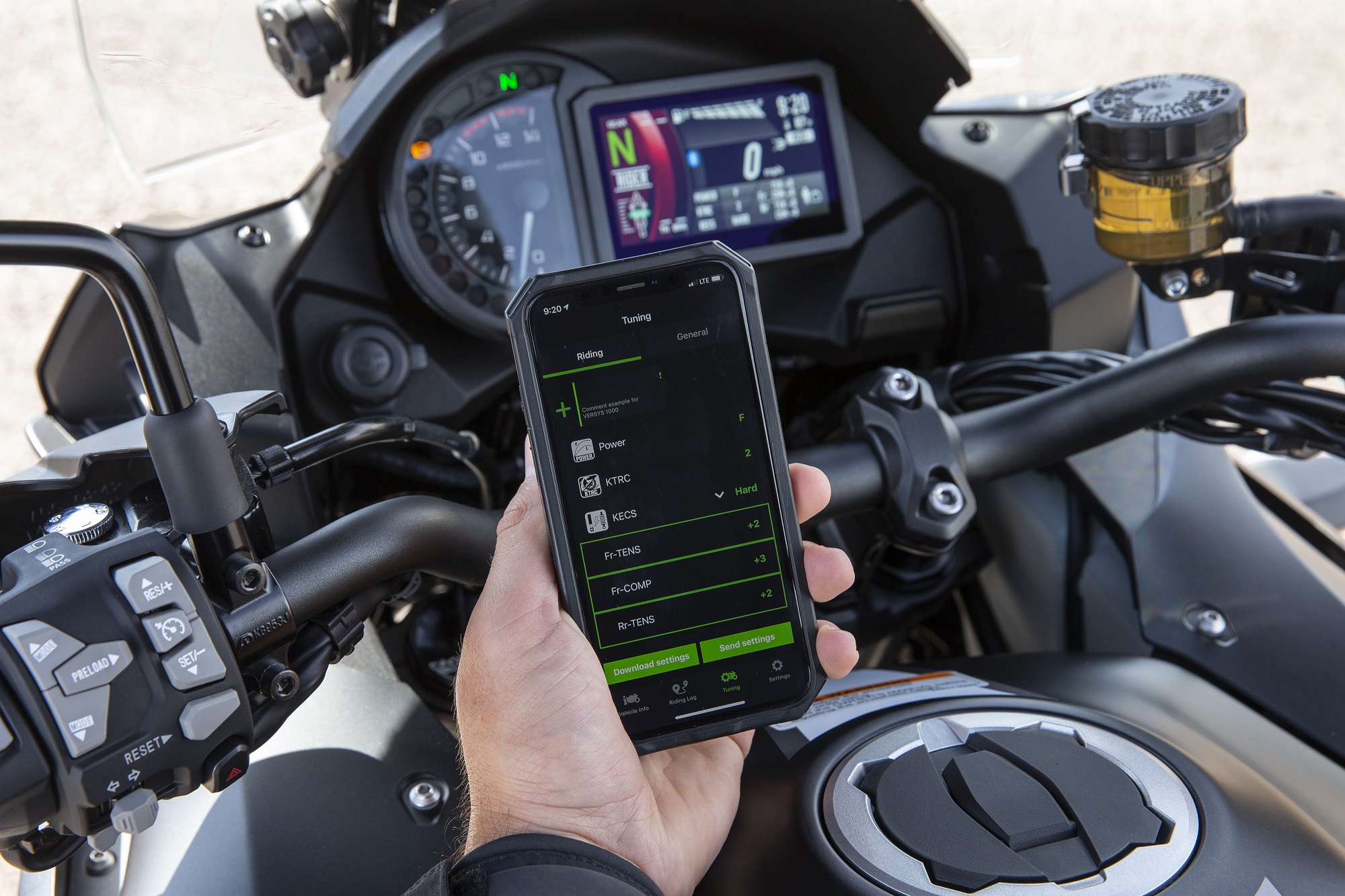
With Kawasaki’s Rideology app, you can make adjustments to your settings using your smartphone. Or, you can scroll through the menu on the TFT display. Photo by Kevin Wing.
The big change: Electronic suspension control
While the electronic features added to the Versys 1000 for 2019 are many, I think the most significant is electronic suspension control. Since Kawasaki loves to give all its features an acronym starting with “K,” they call this KECS, for Kawasaki Electronic Controlled Suspension.
In both the Showa 43 mm cartridge fork and the Showa BFRC Lite rear shock, a solenoid valve adjusts damping on the fly to provide an optimal ride. If the sensor detects an unusual movement — say the front fork is extending rapidly because you just rode into a pothole — the suspension can adjust to minimize the hit. Because there is no intermediary circuit between the sensor and the valve (i.e., direct actuation), Kawasaki says the system responds faster than others, reacting in just one millisecond.
You can also adjust rear preload electronically. Hitting the preload button on the left handgrip lets you choose between settings for a solo rider, solo rider with luggage or two-up with luggage. The front preload is the one suspension setting that still must be done manually.
So how well does KECS work? The bottom line is that it works very well. I was happy with the manual remote preload adjuster on the previous Versys, as I switched from riding solo to riding two-up with my wife. The new suspension makes rear preload changes push-button simple, and that’s only the beginning.
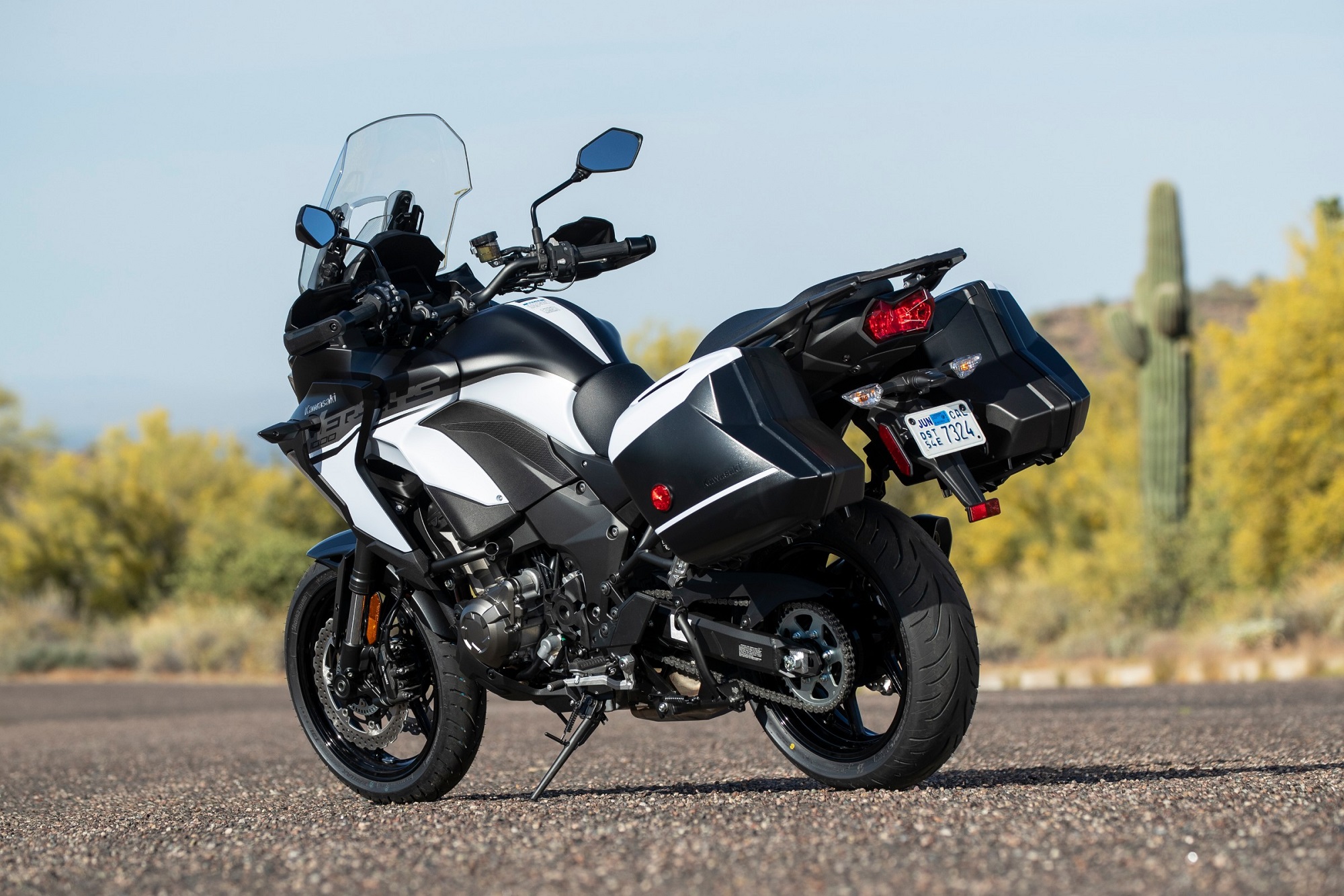
The panniers come stock on the 2019 Kawasaki Versys 1000 SE LT+ and once they are removed, the mounts are not noticeable. Photo by Kevin Wing.
The previous Versys 1000 provided a smooth ride on the freeway but the suspension felt a bit soft once I got into the curvy mountain roads. Of course I could have stopped and pulled out the tool kit and adjusted the suspension once I got to that stretch of smooth, winding pavement and wanted to increase the pace. But who really stops several times during a ride to adjust the suspension?
With KECS on the 2019 Versys 1000, the suspension adjusts for you, many times per second. You can also adjust the base settings yourself by switching, for example, from Road to Sport once you reach the twisties. You can change modes any time the throttle is closed and cruise control is off. Over several thousand miles, I switched many times between Sport, Road and Rain as conditions changed. Now, you really can adjust suspension settings several times per ride.
Even in Sport mode, the suspension, while firm, never felt harsh, maybe because the KECS is sensing the impending jolts and adjusting damping to compensate. Road setting is a good choice for less than perfect pavement. Rain mode softens up the suspension even more and reduces power to 75 percent. It made the suspension a bit too squishy for dry pavement, but of course that’s not what it’s for. Finally, you can customize the Rider setting so you have a fourth option. I felt I didn’t need another setting for riding the bike solo, so I loaded settings into the Rider mode that were what I wanted for riding two-up, when my focus is on relaxed riding and safety. I kept the suspension soft and the intervention from ABS and traction control at high levels.
Overall, I have to say that handling has always been one of the strong points of the Versys line and KECS makes the 1000 SE LT+ the best handling Versys yet.

A simple tap of the button can adjust the suspension settings when you reach the good roads. Photo by Kevin Wing.
More electronics, more K acronyms
In addition to the electronic suspension control, the other big addition to the electronics is the Bosch IMU. Unleash the K acronyms. The IMU works with Kawasaki Traction Control (KTRC) and the Kawasaki Intelligent anti-lock Brake System (KIBS) to create the Kawasaki Corner Management Function (KCMF). KCMF means that the traction control and braking systems are now considering inputs from the IMU about chassis movements such as acceleration, deceleration, lean angle and more, as well as inputs from wheel speed sensors, throttle position, brake pressure, etc. The goal is to reduce the likelihood of losing traction in a corner under braking or acceleration.
KTRC can be set to three different levels or turned off. The first two levels allow different amounts of wheel slip and the third allows none. The system not only considers how much wheel slip is occurring, but also what the rider is doing. So, for example, KTRC will intervene more to reduce slip if the rider is off the throttle than if the rider is on the throttle.
“You want the rider to get off the bike and say, ‘It did exactly what I wanted. When I wanted more and was on the gas, it gave me more,” said Kawasaki Two Wheel Product Manager Croft Long.
How far can you go with cornering traction control and ABS? Years of self-preservation training mean it’s still hard for me to whack the throttle or brakes in a corner just to see if the technology will save me from myself, so I can’t answer definitively. But I did try the ABS, and while I wouldn’t call its intervention unobtrusive, it got the job done and stopped me without any wheel lockup. It’s nice the have the parachute of these systems, even though it’s better if you don’t need them.
Another feature (and acronym) added to the Versys for 2019 is KQS, Kawasaki Quick Shifter, which allows both upshifts and downshifts without the clutch. As is typical, it works better in the higher gears and when you’re riding aggressively, which is when you use it, anyway. A quickshifter is not a feature I really demand on a sport-touring motorcycle, but I realize some people like having it.
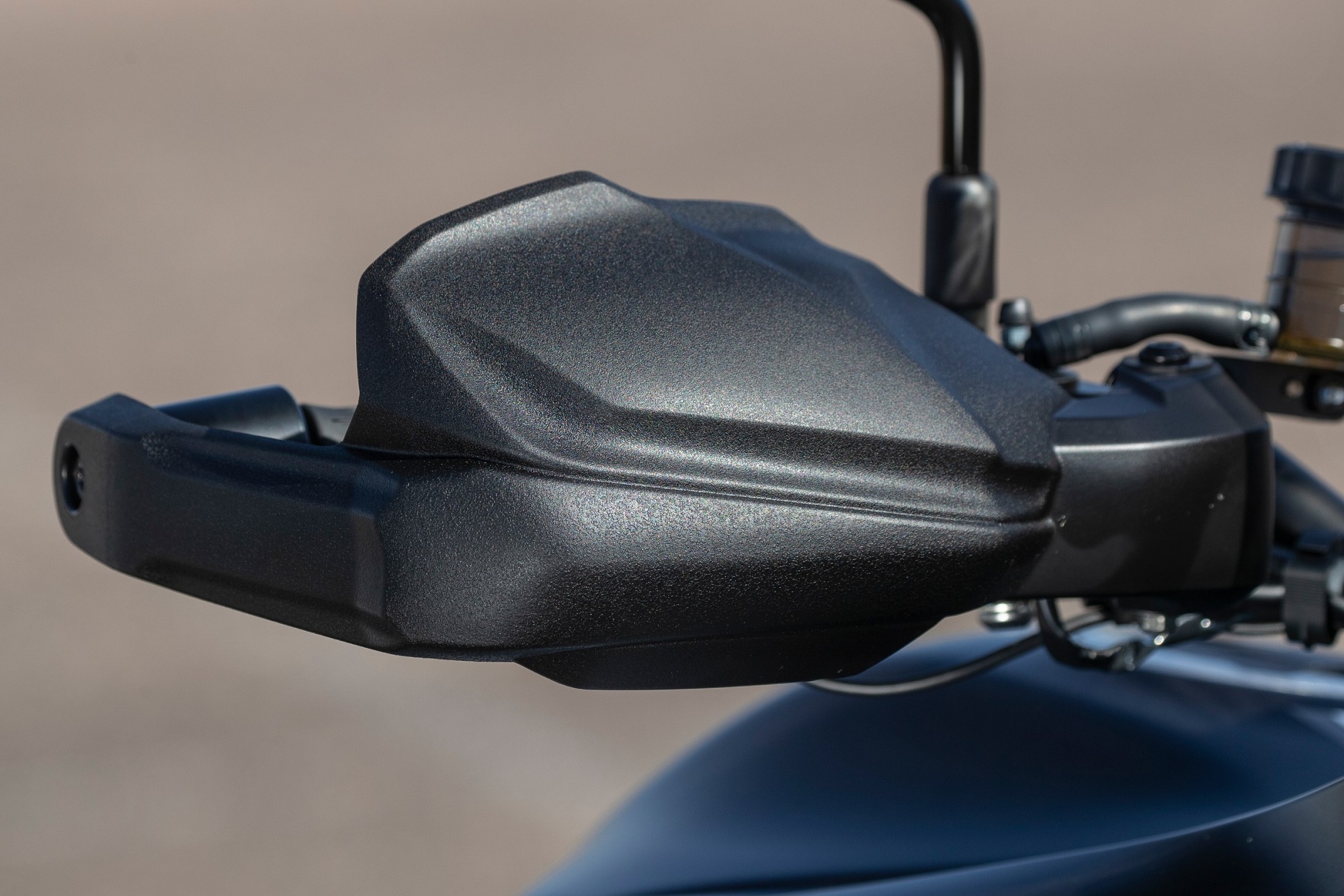
The heated grips don’t get as hot as most but the handguards, which come stock, provide lots of weather protection. Photo by Kevin Wing.
Ergonomics and convenience features
One feature that is a dealbreaker for some buyers in the sport-touring segment is cruise control. Crossing Kansas on U.S. 50, droning home on I-70 on the third day of my three-day ride home, and cruising across northwestern Ohio on U.S. 30 on my way to Road America were all great opportunities to test the Versys’ cruise control. It gets a middling grade.
It does the job of holding a steady speed and giving your wrist a break, but it has its quirks. Setting the cruise speed is easy enough, using the buttons on the left handgrip that are just about like any other car or motorcycle cruise control setup. The weak spot is adjusting your speed.
For example, if I try to increase my cruise speed from 65 to 67 mph using the “up” button, the speed will usually drop about three mph and then slowly rise to the target speed I wanted. Or maybe to some other nearby speed that’s almost what I wanted. I found that when I wanted to change my cruise speed it was easier to cancel cruise control (tap either brake, pull the clutch lever or close the throttle) and reset the speed anew, rather than try to adjust it.
Another very noticeable new feature that’s in keeping with the 2019 Versys’ higher price is the color TFT display, which is paired with an analog, dial tachometer. The screen can be set to two configurations. I’d call one “sport” and one “touring.” The first features bar graphs for throttle position and brake pressure, for example, while the other is a cleaner layout. Either one can be adjusted to a black or white background and both offer a wide range of data, from coolant temperature to electrical charging status to real-time lean angle or fuel mileage and much more.
The display is also where you can change suspension settings and other details. As mentioned above, switching rider modes is just one push of a button (as long as the throttle is closed). You have to go deeper in the menu if you want to adjust suspension settings within those modes, for example. Or, if you prefer, you can download Kawasaki’s Rideology app and you can make any adjustments using your smartphone. Rideology also gives you the option to record the data from your rides, so you can go back and review your route, including details such as lean angle, throttle position, braking force, etc., along the way. Right now, however, there’s no easy way to share that information beyond your own phone.
Features that were handed down from the H2 SX SE are Kawasaki’s highly durable paint, LED cornering lights and the slipper and assist clutch. Small scratches on the paint are “self-healing” with some heat, such as leaving the bike in the sun. Kawasaki showed us a demonstration, scuffing regular paint and the highly durable paint side by side on a piece of metal and the difference was noticeable after a day or two. It doesn’t eliminate scratches, but it minimizes them.
The cornering lights were a feature I wasn’t sure about. On the Versys, they come on at 10, 20 and 30 degrees of lean angle. I don’t ride a lot after dark, but on my first day on the road I did a lot of sightseeing in Arizona and New Mexico and didn’t get to my stop until after sunset. That’s when I found that I really do appreciate the cornering lights. Not because I’m strafing apexes in the dark. But when I was making a low-speed turn onto a highway on ramp, a place where trucks often kick gravel or sand on the pavement, I found that the cornering lights did a great job of lighting up the turn and giving me confidence I wasn’t going to miss some obstacle in the dark. As a result, I think the cornering lights will be just as valuable for low-speed, urban, nighttime riding as they will be for blasting through the darkness on some curvy road.
As for the clutch, it offers impressively light pull and, combined with the quick shifter, should prevent any Versys rider from ever having a tired left hand. With nearly 590 pounds and a seat height just above 33 inches, some shorter riders may not be fully comfortable. With my 32-inch inseam, I was able to get both feet flat on the ground only if I stretched my legs. Kawasaki offers a lower seat as an option. The seating position is the same upright one found on the previous Versys.
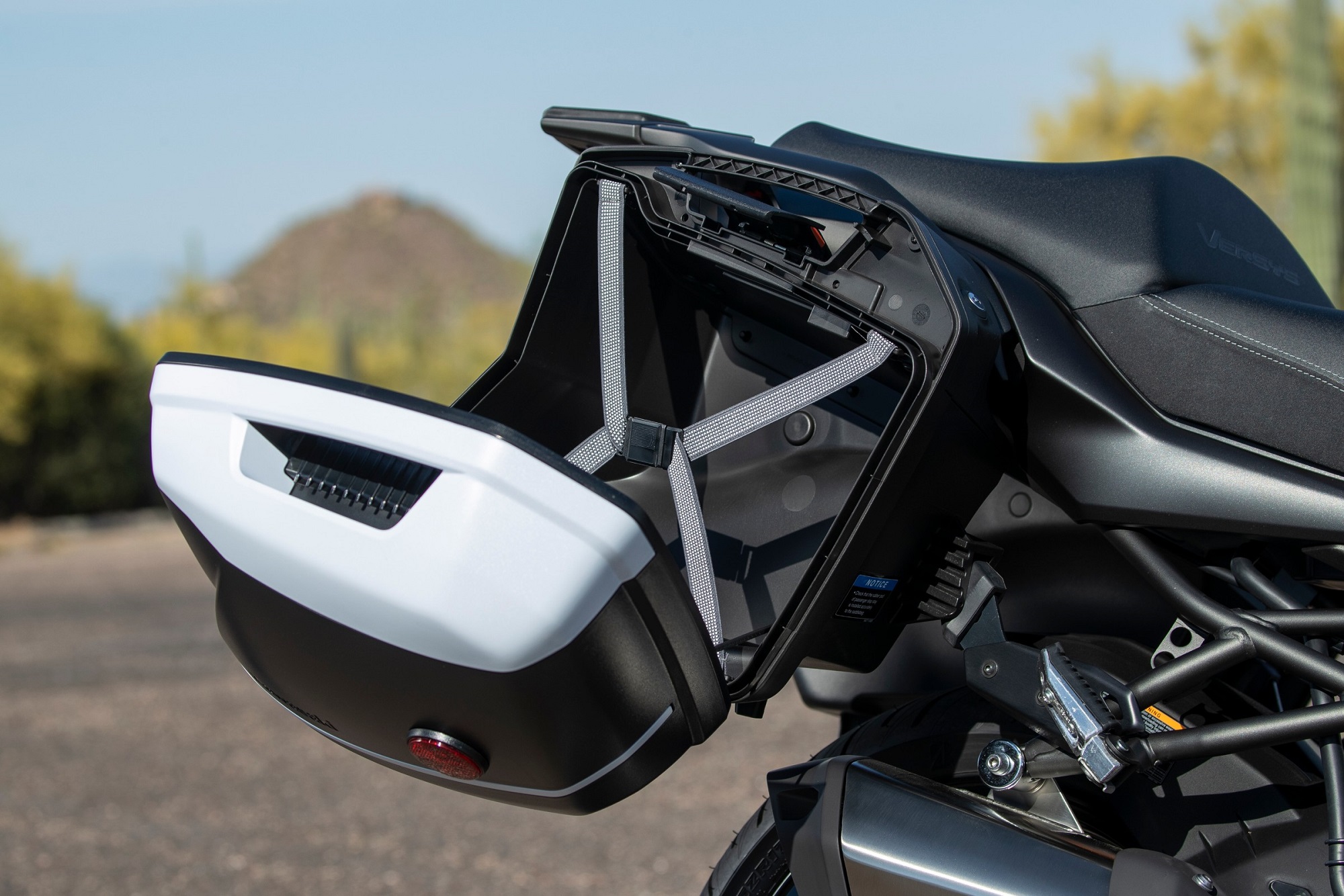
These are the same 28-liter panniers that appear on various Kawasaki models. They work well, fit my size medium Shoei helmet and, when they’re removed, the mounts are not noticeable. Photo by Kevin Wing.
The well integrated, 28-liter panniers (same as on other Kawasakis) come standard on the Versys 1000 SE LT+, as do heated grips and large, plastic handguards to protect from the weather. With most heated grips, I never use the highest setting, because it’s too hot. With the Versys, however, I almost never used the two lower settings. They don’t get that warm. I saw temperatures on the TFT dash of as low as 25 degrees in the mountains and a little more warmth would have been appreciated.
The fairing and manually adjustable windscreen were also enlarged for 2019. Protection is great, but I had trouble finding a perfect position for the windscreen. I usually like the windscreen to be low, putting my head in smooth air flow, except in cold conditions, but in the lowest position, the Versys windscreen caused buffeting. In the highest position it was just slightly too low to put my helmet in the bubble of calm air, unless I slouched a little. I’m five feet, 11 inches tall. Taller or shorter riders may have different experiences.
Range is another long-distance consideration. Many touring riders consider 200 miles the standard, and with its 5.5-gallon tank, the Versys meets that. The longest run I did between fillups was 232 miles.
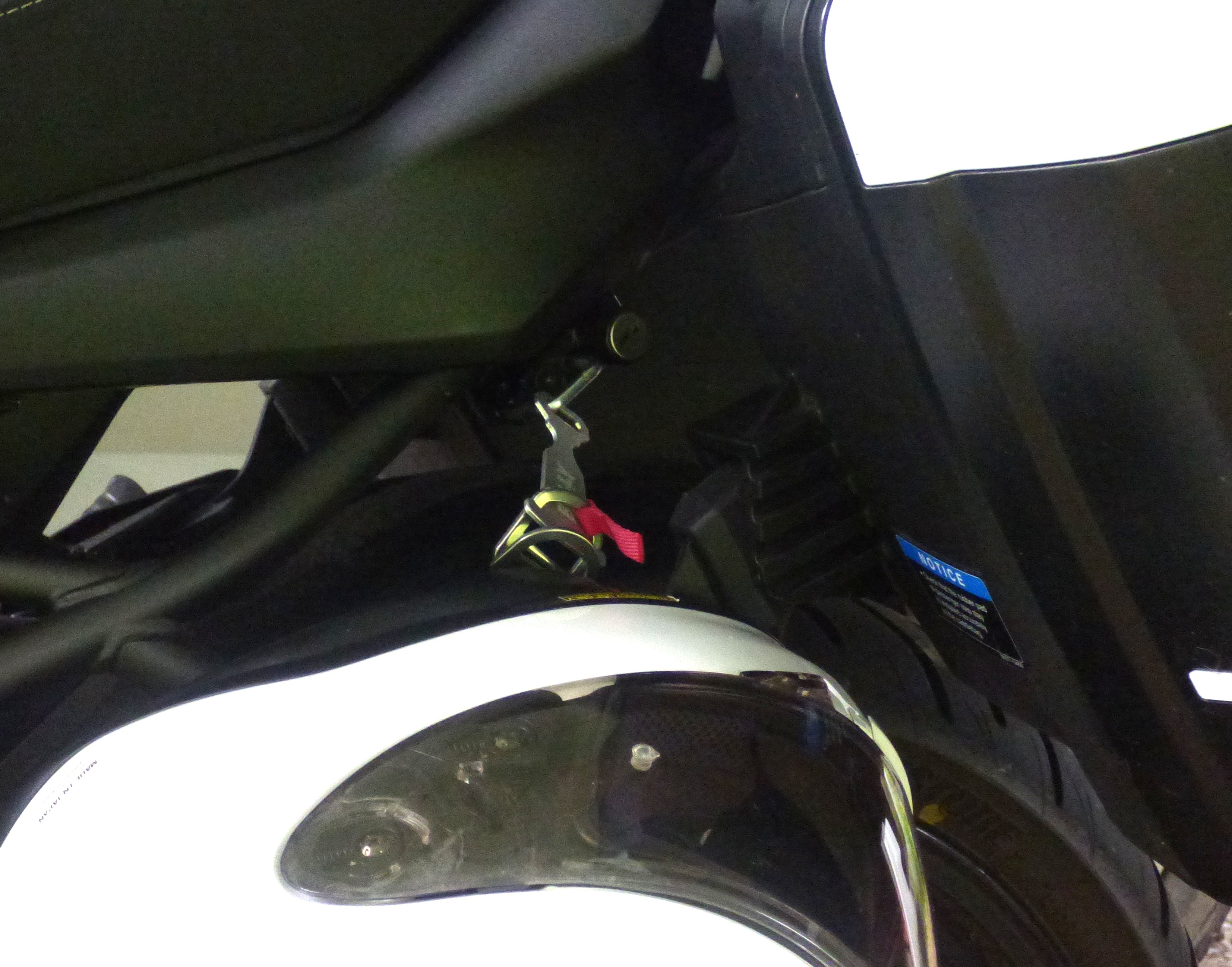
I love the inclusion of a key-operated helmet lock. I just wish it weren’t tucked so far back between the pannier, frame and passenger foot peg. My Bully helmet extension solved that problem.
In addition to all the new high-tech features added to the Versys, there were two low-tech features I appreciated. Back when I started riding, even humble, inexpensive motorcycles had a key-operated helmet lock and a center stand. Now, the former is nearly non-existent and the latter is usually an expensive option. The Versys comes with both. Sure, you can fit a helmet in the pannier, but if you’re traveling, those panniers are going to be full of other stuff, so it’s nice to have a secure way to leave your helmet behind. Also, putting the Versys on the center stand is easy, despite its weight. Actually, it takes a little more effort to get it off the center stand than on it.
Low-tech doesn’t mean low-value. If you asked me to choose between a quick shifter and a helmet lock on my sport-touring motorcycle, I’d take the simple helmet lock every time.
One last low-tech and simple feature that we unfortunately cannot take for granted on all motorcycles: The mirrors actually provide a great view of what’s coming up behind you, not a vibrating, blurry close-up of your elbows.
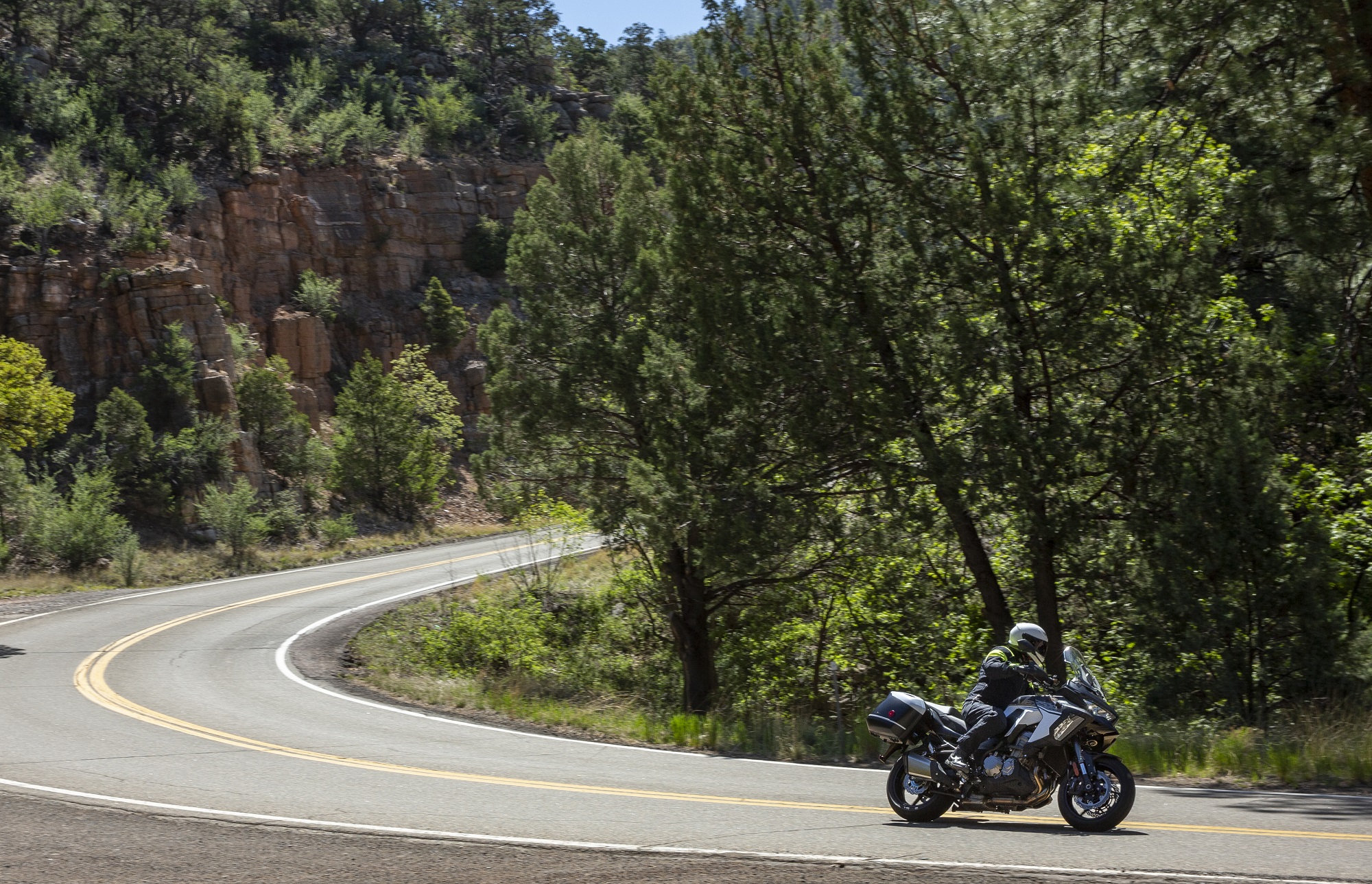
The biggest Versys is capable of chewing up some big miles. Photo by Kevin Wing.
Summing up the Versys 1000 SE LT+
By throwing all its electronic aids on the Versys, it is clear that Kawasaki now expects this bike to be the big seller in its surprisingly wide array of sport-touring bikes, from the aging Concours 14 to the Ninja 1000 to the H2 SX SE. The new features and higher price move the Versys 1000 more directly in competition with the European motorcycles with electronic suspension adjustment mentioned above. All of them are lighter and more powerful, but the Kawasaki is also still less expensive, despite the $5,000 price bump. The MSRP is $17,999 but note two things: First, to give one example, a BMW S 1000 XR with all the stuff that comes standard on the Versys will cost you $21,683. Second, I have already seen Kawasaki dealers offering the new Versys 1000 SE LT+ for prices beginning in the low $16,000 range.
The case for the Versys has changed from being a big, fast, competent, no-frills sport-tourer with a dash of ADV styling at a bargain price to being a big, fast, competent sport-tourer with lots of electronic bells and whistles, still at a price that’s less than some of the fancier competition, but is also more than the cost of a small car. Kawasaki has put its chips on the Versys, and now we’ll see if the move upscale pays off.
| 2019 Kawasaki Versys 1000 SE LT+ | |
|---|---|
| Price (MSRP) | $17,999 |
| Engine | Liquid-cooled inline four, four valves per cylinder |
| Displacement | 1,043 cc |
| Bore x stroke | 77 mm x 56 mm |
| Compression ratio | 10.3:1 |
| Torque | 75.2 foot/pounds @ 7,500 rpm |
| Electronic rider aids | Traction control, electronic suspension adjustment, cruise control, LED cornering lights |
| Transmission | Six gears, Kawasaki Quick Shifter (KQS), chain final drive |
| Front suspension | 43 mm inverted fork, electronic adjustment for rebound and compression damping, manual adjustment for spring preload; 5.9 inches of travel |
| Rear suspension | Single shock, electronic adjustment for rebound and compression damping and preload; 5.9 inches of travel |
| Front brake | Two 310 mm discs, four-piston calipers, ABS |
| Rear brake | Single 250 mm disc, single-piston caliper, ABS |
| Tires front/rear | 120/70ZR17; 180/55ZR17 |
| Steering head angle/trail | 27 degrees/4.0 inches |
| Wheelbase | 59.8 inches |
| Seat height | 33.1 inches |
| Tank capacity | 5.5 gallons |
| Curb weight | 566.7 pounds (add approximately 20 pounds for saddlebags and handguards) |

Thorough review. I have been looking to upgrade and I keep looking at this class of bikes. I haven’t done a test ride yet but I did sit on the 2018 Versys 1000 and it felt a little tall for me. I’m 5-10 30 inch inseam. Does this bike feel the same as the old one?
The frame and seat on the 2019 are the same as on the 2018, so that should be the same for you. I am 5-11, 32-inch inseam and if I stretch my legs I can sort of get both feet flat on the ground. More realistically, I have the balls of my feet on the ground at stops and with the weight of the Versys being relatively high, it is something I consciously think about.
Kawasaki does have an optional seat that is 20 mm lower and a little narrower, but it’s not cheap at $469.95.
What’s with the paint? Is Kawasaki trying to make it look like a cop bike?
I usually don’t even comment on appearance in a motorcycle review because it’s such a subjective thing. Personally, I’m not thrilled with the matte black and white combo on the Versys. One thing I didn’t mention about the paint, however, is that this is Kawasaki’s “highly durable paint.” That means light scratches actually self-heal a little when left in the sun. (Actually, it’s heat, not sun, that makes the process work, but most people don’t have a motorcycle-sized oven, so you park it in the sun.) They demonstrated this to us using a piece of body work painted with regular and the self-healing paint. It’s not going to cure a deep scratch or gouge, but light scuffs do diminish over time.
I’m sold on the tech but these bikes are pricy especially the Multistrada. The Versys looks like an alternative I could maybe afford but what about the maintenance costs.
Kawasaki calls for valve adjustments at 15,200-mile interviews and oil changes at half that. I suspect the number of shop hours on the Versys will also be less than adjusting the valves on the VVT engine in the Multistrada.
Other costs are tires and gas. Kawasaki says the Versys wants 90 octane (R+M/2). Since most gas stations in the United States have some combination of 89, 91 and 93, I usually put 89 in it with no pinging or problems. The bike comes stock with Bridgestone Battlax T31 sport-touring tires and as of this writing I have almost 5,000 miles on the bike. The rear has plenty more miles left, so I’m impressed with longevity, considering the number of straight highway miles I’ve done and the weight of the bike. Sport-touring tires are so great these days you give up very little grip for better mileage.